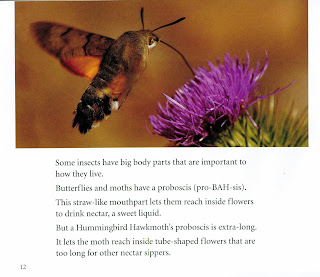Hello teachers and parents! My next few blogs are especially for you to help you share my books with children.
For those of you interested in writing non-fiction, please use these blogs as an opportunity to dig into my books and check out how I combine language and pictures to make learning exciting, involving, and as interactive as possible. Then, coming soon, will be some new blogs just for you.
First, let's dig into INSECTS Biggest! Littlest! (Boyds Mills, 2009)
Look on page 2 to see a female Pea Aphid and her babies. How many babies are there? How tiny are they?
You might be surprised to learn aphids are born alive. Look at the picture (below) from Creepy Crawly Baby Bugs Creepy Crawly Baby Bugs (Walker, 1996).
The mother aphid keeps her developing young safe by holding the eggs inside her body until they hatch. Then the young emerge ready to fend for themselves.
Can you eat like a Hummingbird Hawkmoth? Look on page 12 to see how the Hummingbird Hawkmoth drinks nectar, sweet liquid produced by flowers. How does it help the moth to have an extra-long proboscis, straw-like mouthparts?
Look at the honeybees on page 21. Are honeybees careful to stay away from other honeybees? Their behavior is related to the fact honeybees depend on each other to do a big job: warm up or cool off their hive (home). Think what your body does when you get chilled? You shiver. So do bees. Each shivering bee gives off a tiny bit of heat. Whenever the temperature drops below about 55F/13C outside, the shivering honeybees group together in a ball around the queen, the female bee that producing eggs. The colder it gets outside, the tighter the bees huddle. Even when it’s below freezing, the center of the bee cluster is likely to be about 90F/32C.
Now wave your hands in front of your face. Feel the cool breeze? No wonder lots of bees fanning their wings can cool the hive. They definitely need to keep the hive from getting too warm. The wax forming the cells inside the hive will soften if the temperature gets warmer than 93.2F/34C.
Check out the wasp’s paper house on page 23.
The following activity from What Happens Next?(Longstreet, 1995) will let children make paper and see how wasps change bits of wood into their building material.
1. Tear 20 sheets of newspaper into tiny pieces. Soak in a bowl of water overnight.
2. Cover your work area with newspaper and a stack of three paper towels.
3. Have an adult cut a 5 inch/13 centimeter square of window screen (available at hardware stores). Use scissrs to cut waxed paper squares the same size.
4. Pour two cups of water into a blender. Add a cup of wet paper and a tablespoon of cornstarch. Blend until it looks like a gray milkshake. Pour into a clean bowl. Push the screen into the bowl until it’s covered with mush and lift straight up.
5. Top with waxed paper. Flip, waxed paper side down, onto the towels. Cover with three more paper towels.
6. Use a rolling pin to squeeze out water. Remove the wet towels and screen.
7. Turn over onto a dry paper towel, peel off the waxed paper and let dry. Repeat to make more paper.
These highly magnified views from What Happens Next let you compare man-made typing paper and wasp paper. In what ways do they look alike? How are they different?
Now, go on a bug hunt. The following insects are pictured in INSECTS Biggest! Littlest! Find them. Check out how being big or little or having big or little body parts makes all the difference in their lives.
Aphid
Stick insect
Weevil
Stalk-eyed Fly
Toothbrush Caterpillar
Raja Brooke Birdwing Butterfly
Subscribe to:
Post Comments (Atom)
MY SOUTH POLE JOURNEY
On December 14, 1911 Roald Amundsen led the first ever journey to stand at the Earth's South Pole. It involved lots of planning and prep...

-
WHAT IF YOU HAD!? SHARE-A-THON Thank you to all you creative people who are finding COOL ways to turn my WHAT IF YOU HAD!? books in...
-
I'm a redhead And I'm proud of it. In fact, being a redhead is a big thing in my family. I have redheaded cousins and a redhe...
-
I love when teachers post activities or share other ways they're making the most of my books in their classrooms. So I'm delighted...














No comments:
Post a Comment